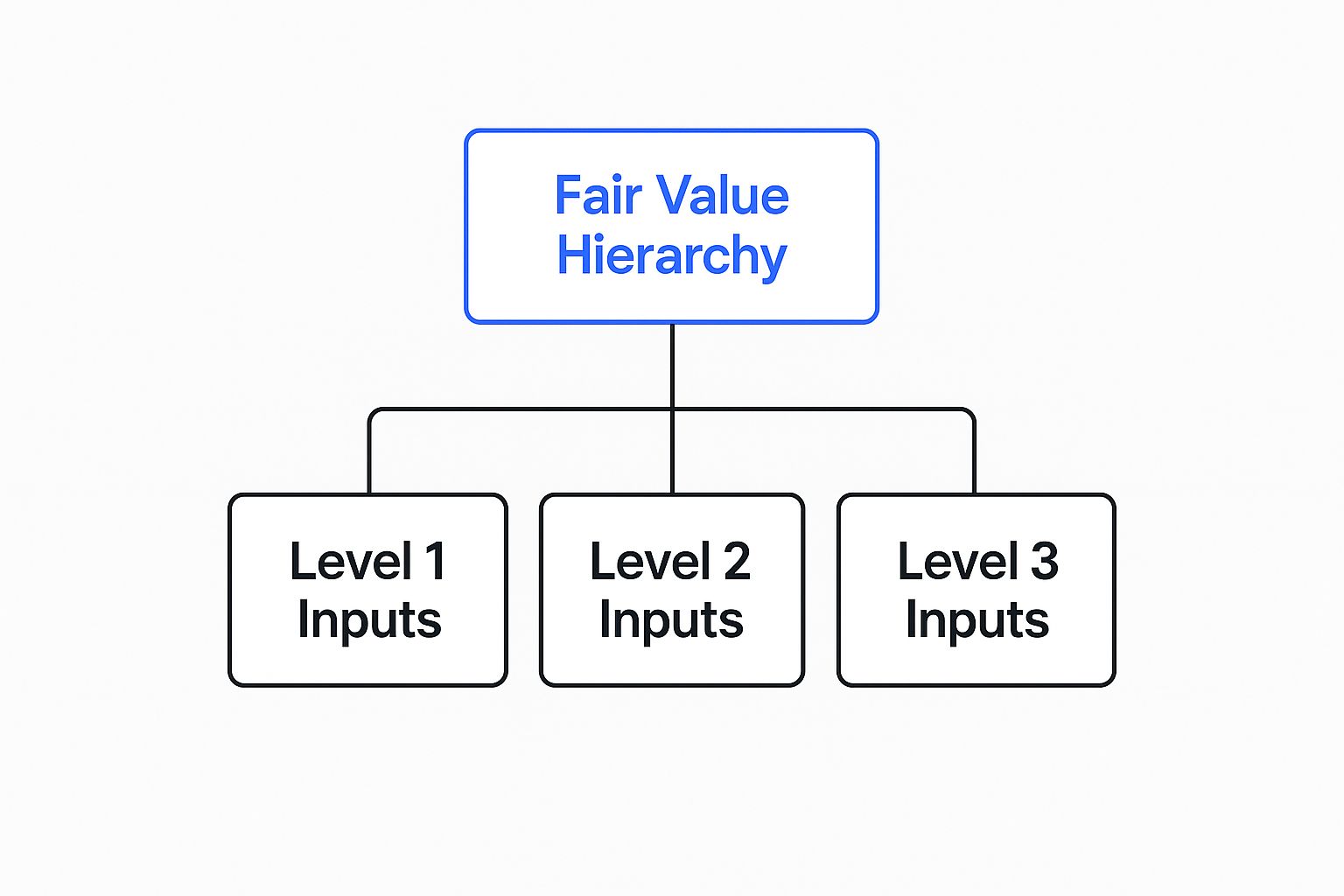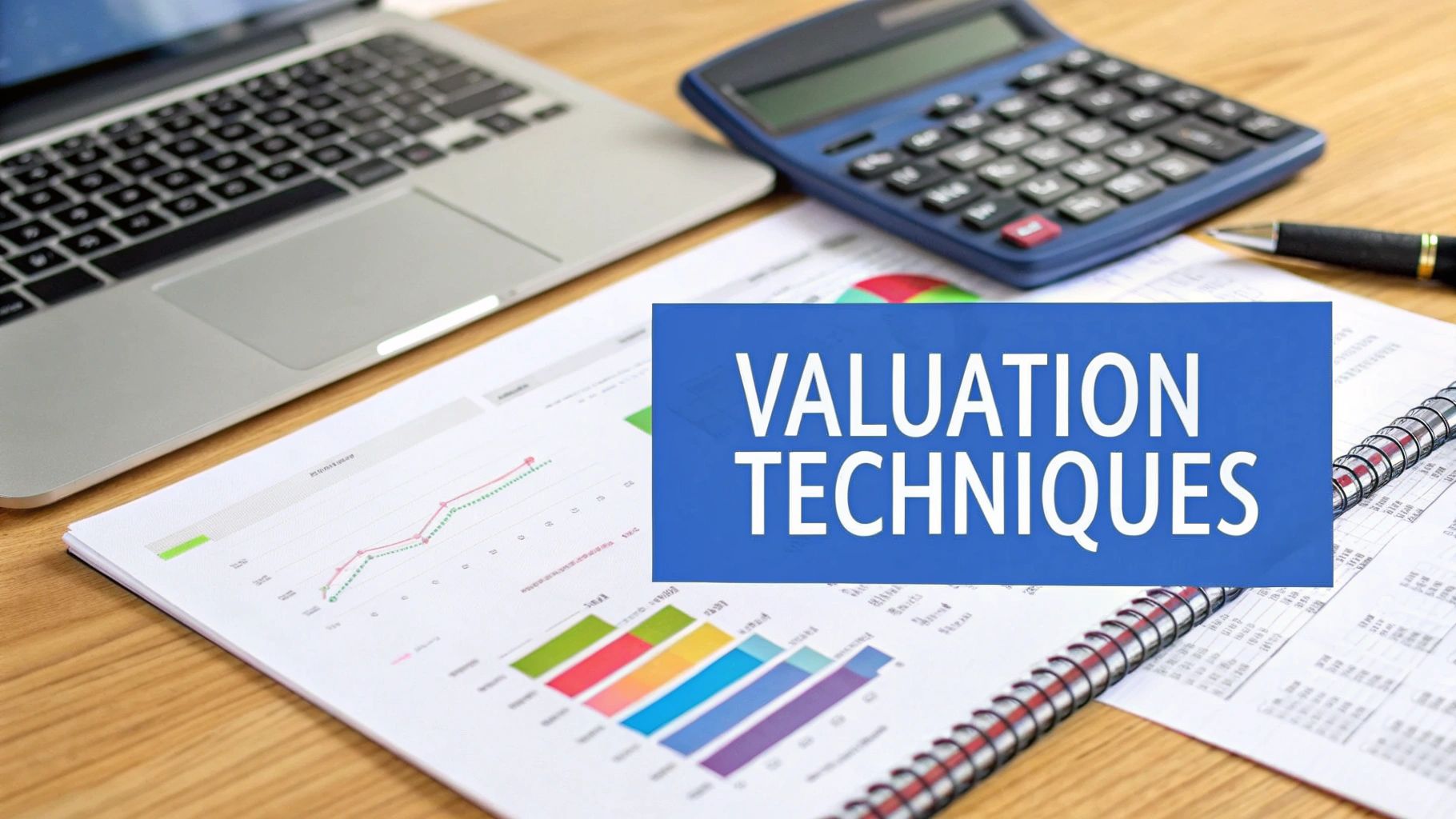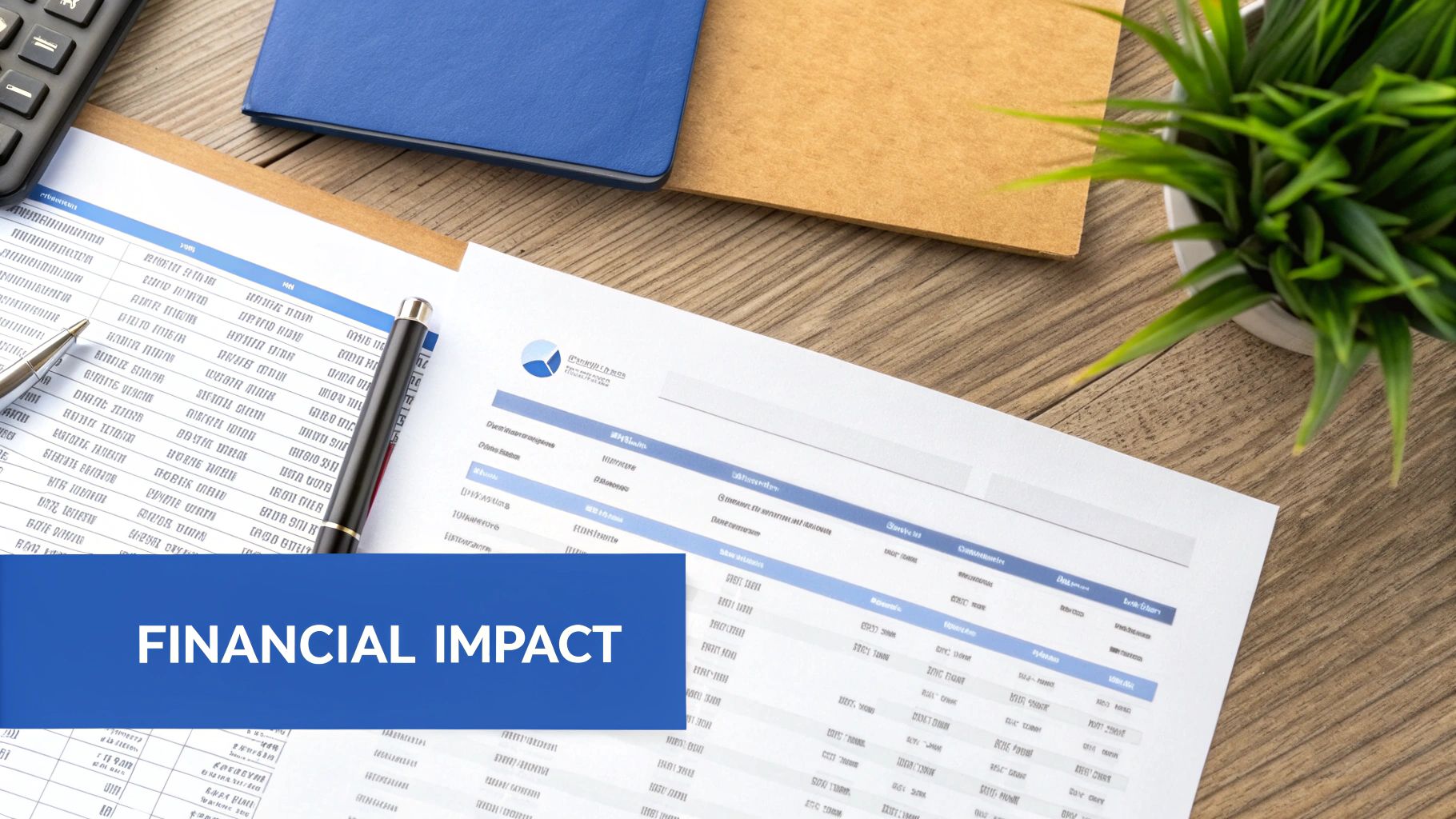Understand ASC 820 fair value with this clear guide. Learn the valuation hierarchy, key techniques, and disclosure rules to ensure compliance.

ASC 820 is the accounting standard that gives us a common language for talking about "fair value." In simple terms, it's the playbook for figuring out what an asset is worth right now. The standard defines fair value, creates a system for measuring it, and lays out exactly what you need to disclose in your financial reports.
The whole point is to determine the price you'd get if you sold an asset—or what you'd pay to offload a liability—in a normal, everyday transaction. It’s not a fire sale. It’s not a forced deal. It's just a regular transaction between willing and knowledgeable parties. This standard ensures everyone is playing by the same rules, which brings much-needed consistency to financial reporting.

Before ASC 820 came along, things were a bit like the Wild West. Valuing certain assets and liabilities was often a free-for-all, leaving investors and regulators to decipher a mishmash of different valuation methods. One fund might use one set of assumptions, while another used a completely different one, making their financial statements impossible to compare. This lack of a universal standard just created confusion and risk.
To clean things up, the Financial Accounting Standards Board (FASB) introduced ASC 820 back in 2006. Its mission was clear: create a single, consistent framework for measuring fair value. The standard defines it as the price that would be received to sell an asset or paid to transfer a liability in an orderly transaction between market participants.
The key concept to grasp here is the “exit price.” Don't think about what you paid for an asset (its historical cost). Instead, think about what you could sell it for today.
Imagine your fund bought a commercial building for $5 million five years ago. Under ASC 820, its value on your books today isn't that original $5 million. It's the price a willing buyer in the current market would actually pay for it. This could be more, or it could be less.
This principle forces a huge mental shift. You have to move away from an internal, "what-we-think-it's-worth" mindset to an external, market-based view. The standard always pushes you to use observable market data—what the market says something is worth—over your own internal guesswork or hopes. This focus on objective evidence is what builds credible financial reports.
For anyone managing a fund, this consistency is the bedrock of trust with your limited partners (LPs). When LPs get their quarterly reports, they need to have confidence that the valuations are accurate and reliable, not just wishful thinking.
ASC 820 provides that universal rulebook. It ensures every fund is measuring value in a comparable way, which is absolutely essential for fairly assessing performance. Want to dig deeper? You can read more in our guide about how to find fair market value accurately.
By establishing this common ground for valuation, ASC 820 achieves a few critical goals:
At the heart of ASC 820 is a simple, three-tiered system. This isn't about ranking which asset is "better" than another. Instead, the fair value hierarchy is all about classifying the reliability and observability of the data you use to come up with a valuation.
Think of it like a pyramid. The top is reserved for the most objective, clear-cut market data, while the bottom level involves more subjective, internal assumptions. This framework gives everyone a clear roadmap for valuation, forcing a priority on verifiable, external market information whenever possible. The whole point is to make financial statements more credible by minimizing the reliance on guesswork.
This structure shows the flow from the most observable inputs to the least.

As you can see, the three levels are distinct. They guide valuers to always start with the most reliable data they can find for any given asset or liability.
Level 1 inputs are the easiest to understand and the most reliable. Why? Because they are quoted prices for identical assets or liabilities in active markets. There’s no room for debate, no adjustments needed. It is what it is. This is the gold standard for ASC 820 fair value.
Take a stock like Apple (AAPL). You can pull up its price on the Nasdaq any second of the day. That real-time price is a direct, observable input for an identical asset trading in a very active market. Simple as that.
Moving down a step, Level 2 inputs are still based on observable market data, but not for the exact same asset. This is where a bit of analysis and judgment comes into play. You’re essentially using market data for similar—not identical—assets or liabilities.
Imagine you need to value an office building. There's no stock ticker for your specific property. However, you can look up recent sales prices for comparable buildings in the same neighborhood. You'd then adjust those prices based on factors like square footage, age, or specific location. You’re still using observable inputs; you just have to do a little more work to connect them to your asset. Many corporate bonds, which don't trade as often as stocks, also fall into this bucket.
Level 3 is where things get tricky. These inputs are unobservable and force you to rely on your own assumptions and financial models. This level is reserved for assets and liabilities where there’s little to no market activity to draw from, making them the toughest to value and the ones auditors will scrutinize the most.
"Level 3 valuations require significant judgment, making robust documentation and defensible assumptions critically important. This is where transparency becomes paramount for building investor confidence."
A classic example is a private equity investment in an early-stage startup. There are no public comps, no active markets, nothing. The valuation has to come from an internal model, like a discounted cash flow (DCF) analysis built on projections for future revenue, profit margins, and risk. These are your assumptions about what might happen.
It’s this subjectivity that puts Level 3 assets under the microscope. Research digging into SEC filings shows that while Level 1 assets account for roughly 40% of fair value measurements and Level 2 makes up 45%–50%, the more subjective Level 3 assets still represent a meaningful 10%–15% of the total. You can dive deeper into these market trends from Richey May to see the full breakdown.
To help put it all together, here’s a quick overview of how the three levels compare.
| Level | Input Type | Description | Example |
|---|---|---|---|
| Level 1 | Observable | Unadjusted quoted prices in active markets for identical assets or liabilities. | Publicly traded stocks, U.S. Treasury bonds. |
| Level 2 | Observable | Inputs other than quoted prices that are observable, either directly or indirectly (e.g., for similar assets). | Corporate bonds, interest rate swaps, most real estate properties. |
| Level 3 | Unobservable | Inputs based on the entity's own assumptions and data, used when observable inputs are not available. | Private equity investments, complex derivatives, goodwill. |
This table clearly lays out the progression from pure market data (Level 1) to internally-generated estimates (Level 3), which is the fundamental concept driving the ASC 820 framework.

Getting a handle on the fair value hierarchy is the first step. The next is figuring out how to actually calculate the value. ASC 820 doesn't lock you into a single method; instead, it outlines three core valuation techniques.
Choosing the right one isn’t a matter of preference. It comes down to the nature of the asset itself and the quality of the data you can get your hands on. These techniques are the practical tools we use to arrive at the ASC 820 fair value numbers that ultimately land on the financial statements.
The Market Approach is about as straightforward as it gets. You’re essentially looking at what the market is telling you. This technique relies on prices and other data from actual market transactions for assets or liabilities that are identical—or at least very similar—to what you're valuing.
Think of how a real estate agent prices a house. They pull "comps" by looking at what similar homes in the neighborhood have recently sold for. That’s the Market Approach in a nutshell. It works best when you have a decent amount of market activity to reference, which is why it’s the go-to for many Level 1 and Level 2 assets.
What happens when there are no good market "comps"? You pivot to the Income Approach, which focuses on an asset's future earning power. This method takes future cash flows or earnings and converts them into a single, present-day value.
It answers the fundamental question: "What are the future economic benefits of this asset worth today?" This makes it essential for valuing assets that are expected to generate cash over time, like private equity holdings or complex derivatives. For instance, valuing an option requires knowing how to calculate option premium, a classic income-based calculation.
A discounted cash flow (DCF) analysis is the most common form of the Income Approach. This involves forecasting an asset's future cash flows and then "discounting" them back to their present value using a rate that reflects the risk involved.
Finally, we have the Cost Approach, which looks at value from a replacement perspective. The core idea is to determine how much it would cost, right now, to replace the service capacity of an asset. You’re essentially asking, “What would I have to spend to build or buy a substitute asset that provides the same utility?”
This method is the logical choice for unique, often tangible assets that don’t trade on an active market and don’t produce their own distinct income stream. While less common for financial instruments, it's incredibly useful for valuing certain physical assets.
https://www.youtube.com/embed/uu0qj9jVsmk
When it comes to Level 3 assets, we’re in the deep end of the pool. This is where the principles of ASC 820 fair value get their toughest workout. We're talking about assets like private equity holdings or venture capital investments where there's no active market to give you a price. You're left relying on your own models and a whole lot of judgment.
Valuing these assets is as much an art as it is a science, and it absolutely demands meticulous documentation. Your goal isn't just to find a number; it's to build a valuation that you can stand behind and defend. Every assumption needs to be clearly laid out, logically supported, and backed by the best information you can get your hands on. Trust me, auditors will poke and prod at these valuations, so explaining the "why" behind your model is just as critical as the final number it spits out.
For these kinds of assets, where the inputs aren't readily available, working through a comprehensive due diligence checklist can be a lifesaver. It provides a solid framework to make sure you're not missing anything crucial as you build out your valuation.
First things first, you have to pick the right tool for the job. Since there's no market data to lean on, the Income Approach is usually the way to go. More specifically, a Discounted Cash Flow (DCF) model is the go-to method for many Level 3 valuations. It's all about projecting the asset's future cash flows and then discounting them back to what they're worth today.
Once you’ve chosen your method, the real work begins: identifying and justifying your unobservable inputs. These are the assumptions that will make or break your entire model.
A quick heads-up: the company-specific risk premium (CSRP) you build into your discount rate is getting a lot more attention these days. Regulators aren't accepting a subjective "fudge factor" anymore. They expect to see real quantitative analysis backing it up.
Let's walk through a quick example. Imagine your fund needs to value its stake in an early-stage tech startup. There are no publicly traded companies that look anything like it, so you have to build a DCF model from scratch.
Following a structured process like this turns what could be a purely subjective exercise into a documented, defensible analysis. If you want to dive deeper into this, check out our complete guide to the valuation of private company assets.

The entire ASC 820 fair value framework boils down to one simple idea: transparency. Getting the valuation right is a huge part of the job, but if you can’t communicate it clearly, you’ve only fought half the battle. These disclosure requirements aren’t just another compliance box to check; they are how you build and maintain trust with your investors, LPs, and regulators.
Think of these rules as a mandate to pull back the curtain on your valuation process. You're giving stakeholders the context they need to understand the risk and reliability behind the numbers on a financial statement. It’s all about providing a clear "why" and "how" for every fair value figure.
At its core, ASC 820 demands a detailed breakdown of your fair value measurements. For every reporting period, you need to lay out specific information that sheds light on your valuation techniques and the inputs you used. This gives anyone reading your financials a fair shot at making an informed judgment.
The key disclosures typically include:
This level of detail turns a simple balance sheet number into a much richer story.
Of all the disclosures, the Level 3 reconciliation gets the most attention—and for good reason. These are the assets valued with unobservable inputs and internal models, which means they carry the most subjectivity and risk. ASC 820 requires a granular reconciliation showing every single movement in your Level 3 assets from the start of the period to the end.
This reconciliation is more than just a table of numbers; it’s the story of your most subjective valuations. It gives a crucial window into how management's judgments and market shifts impacted the portfolio's value over time.
This "roll-forward" report must individually account for:
This process forces you to create a clear, auditable narrative for your most complex assets. Keeping this level of detail is fundamental to strong financial reporting, a topic we dive into in our guide on 8 crucial audit trail best practices for 2025.
In the end, these disclosures are about more than just meeting a standard. They're a powerful way to demonstrate accountability and communicate your fund’s value with precision and integrity.
Putting the ASC 820 fair value framework into practice isn't always straightforward. Even experienced finance teams run into the same old roadblocks, especially when they’re trying to value assets that don't have a clear price tag. Getting this right is absolutely critical for creating financial statements that can stand up to scrutiny.
One of the biggest headaches? Sourcing solid data for Level 2 inputs. When you can't find an identical asset, you have to lean on "comparables." But finding a truly similar asset and then making the right adjustments is part art, part science. This is where you often get into lengthy back-and-forths with auditors about whether your inputs are good enough.
Then there's the high-stakes world of Level 3 models. These valuations are built on unobservable inputs—things like your own internal growth forecasts or the discount rates you've chosen. Naturally, they draw a ton of attention. Trying to justify every assumption, particularly something as subjective as a company-specific risk premium (CSRP), is a classic audit battleground.
Instead of just bracing for impact when the auditors show up, you can get ahead of these issues. A little proactive discipline goes a long way in building a valuation process that’s solid from the start.
Here are a few proven ways to sidestep the usual problems:
Lean on Third-Party Pricing Services: For those tricky Level 2 assets, bringing in a reputable pricing service gives you an objective, market-based data point. It’s a lot easier to stand behind their numbers than a valuation you cooked up entirely on your own.
Build Strong Internal Controls: Make a formal review process your new best friend. Every valuation should be double-checked by someone who wasn't involved in the original calculation. A fresh pair of eyes can catch flawed assumptions before they become a real issue.
Call in the Experts: When the stakes are high with a complex Level 3 asset, don’t go it alone. Hiring an independent valuation firm is a smart move. Their unbiased analysis adds a powerful layer of credibility and support that's tough to argue with.
Look, the key is to document every single assumption, grab objective data whenever you can, and set up a serious internal review process. When you do that, valuation stops being a compliance nightmare and starts becoming a strategic advantage. You'll find your audits go a whole lot smoother every single time.
Even with a solid grasp of the basics, some of the finer points of ASC 820 fair value can be tricky. Let's tackle a few of the questions that come up most often in practice.
Think of an orderly transaction as a sale that happens under normal market conditions, with a typical amount of time for marketing and due diligence. It’s the direct opposite of a fire sale or a forced liquidation where the seller is under the gun to sell immediately.
This distinction is absolutely critical. Why? Because a desperate, rushed sale will almost always fetch a lower price—one that doesn't truly reflect what the market would pay under normal circumstances. That's why it can't be used to determine fair value.
This is a common point of confusion. Under ASC 820, fair value is the price you would receive for an asset before you subtract any costs associated with the sale, like broker commissions or legal fees. Those expenses are accounted for separately.
The logic here is that these costs are tied to the transaction itself, not the intrinsic value of the asset or liability.
Think of it this way: fair value is about what the asset is worth in the market, completely separate from the costs you might incur to actually sell it. The exit price is always measured gross of these costs.
Absolutely. Assets can—and often do—move between the different levels of the fair value hierarchy, and it's mandatory to disclose these shifts. A classic example is a security that was previously valued using observable Level 2 inputs. If the market for that security suddenly becomes inactive, it might need to be reclassified as Level 3.
Companies are required to have a consistent policy for timing these transfers. Most recognize them at the end of the reporting period, which gives investors a clear, transparent picture of how market dynamics are affecting asset valuations.
Are you ready to ditch the spreadsheets and bring real efficiency to your fund's operations? Fundpilot offers institutional-grade reporting, automated administration, and audit-ready records. This lets you focus your energy on what matters most: raising capital and making smarter investment decisions. See how it works at https://www.fundpilot.app.